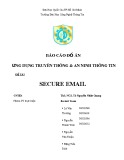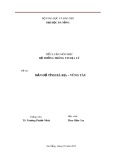
The Random Oracle Methodology, Revisited∗
Ran Canetti†Oded Goldreich‡Shai Halevi§
August 6, 2002
Abstract
We take a critical look at the relationship between the security of cryptographic schemes in
the Random Oracle Model, and the security of the schemes that result from implementing the
random oracle by so called “cryptographic hash functions”.
The main result of this paper is a negative one: There exist signature and encryption schemes
that are secure in the Random Oracle Model, but for which any implementation of the random
oracle results in insecure schemes.
In the process of devising the above schemes, we consider possible definitions for the notion
of a “good implementation” of a random oracle, pointing out limitations and challenges.
Keywords: Correlation Intractability,
•Cryptography (Encryption and Signature Schemes, The Random Oracle model);
•Complexity Theory (diagonalization, application of CS-Proofs).
∗Extended abstract has appeared in the Proc. of the 30th ACM Symp. on Theory of Computing (STOC), pages
209–218, 1998.
†IBM Watson, P.O. Box 704, Yorktown Height, NY 10598, USA. E-mail: canetti@watson.ibm.com
‡Department of Computer Science, Weizmann Institute of Science, Rehovot, Israel. E-mail:
oded@wisdom.weizmann.ac.il. Work done while visiting LCS, MIT. Partially supported by DARPA grant DABT63-
96-C-0018.
§IBM Watson, P.O. Box 704, Yorktown Height, NY 10598, USA. E-mail: shaih@watson.ibm.com
1

Contents
1 Introduction 2
1.1 The Setting . . . . . . . . . . . . . . . . . . . . . . . . . . . . . . . . . . . . . . . . . 2
1.1.1 The Random Oracle Model . . . . . . . . . . . . . . . . . . . . . . . . . . . . 3
1.1.2 Implementing an ideal system . . . . . . . . . . . . . . . . . . . . . . . . . . . 3
1.2 Our Results . . . . . . . . . . . . . . . . . . . . . . . . . . . . . . . . . . . . . . . . . 5
1.2.1 Correlation intractability . . . . . . . . . . . . . . . . . . . . . . . . . . . . . 5
1.2.2 Failures of the Random Oracle Methodology . . . . . . . . . . . . . . . . . . 6
1.3 Techniques . . . . . . . . . . . . . . . . . . . . . . . . . . . . . . . . . . . . . . . . . 7
1.4 Related Work . . . . . . . . . . . . . . . . . . . . . . . . . . . . . . . . . . . . . . . . 7
1.4.1 Previous Work . . . . . . . . . . . . . . . . . . . . . . . . . . . . . . . . . . . 7
1.4.2 Subsequent Work . . . . . . . . . . . . . . . . . . . . . . . . . . . . . . . . . . 7
1.5 Organization . . . . . . . . . . . . . . . . . . . . . . . . . . . . . . . . . . . . . . . . 9
2 Preliminaries 9
2.1 Function Ensembles . . . . . . . . . . . . . . . . . . . . . . . . . . . . . . . . . . . . 9
2.2 CS Proofs . . . . . . . . . . . . . . . . . . . . . . . . . . . . . . . . . . . . . . . . . . 10
3 Correlation Intractability 12
3.1 Actual Definitions . . . . . . . . . . . . . . . . . . . . . . . . . . . . . . . . . . . . . 12
3.2 Correlation-intractable ensembles do not exist . . . . . . . . . . . . . . . . . . . . . . 13
4 Failures of the Random Oracle Methodology 14
4.1 First Step . . . . . . . . . . . . . . . . . . . . . . . . . . . . . . . . . . . . . . . . . . 15
4.2 Second Step . . . . . . . . . . . . . . . . . . . . . . . . . . . . . . . . . . . . . . . . . 17
4.3 Third step . . . . . . . . . . . . . . . . . . . . . . . . . . . . . . . . . . . . . . . . . . 18
4.4 Encryption . . . . . . . . . . . . . . . . . . . . . . . . . . . . . . . . . . . . . . . . . 20
5 Restricted ensembles and other directions 22
5.1 On the non-existence of restricted correlation intractable ensembles . . . . . . . . . . 23
5.2 Other limitations of restricted correlation intractable ensembles . . . . . . . . . . . . 24
5.3 On correlation intractability for multiple invocations . . . . . . . . . . . . . . . . . . 25
5.4 Implications for signatures and encryption . . . . . . . . . . . . . . . . . . . . . . . . 26
5.5 On weak restricted correlation-intractable ensembles . . . . . . . . . . . . . . . . . . 26
5.6 On the failure of some specific constructions . . . . . . . . . . . . . . . . . . . . . . . 28
6 Conclusions 29
6.1 Ran’s Conclusions . . . . . . . . . . . . . . . . . . . . . . . . . . . . . . . . . . . . . 29
6.2 Oded’s Conclusions . . . . . . . . . . . . . . . . . . . . . . . . . . . . . . . . . . . . . 31
6.3 Shai’s Conclusions . . . . . . . . . . . . . . . . . . . . . . . . . . . . . . . . . . . . . 32
1

1 Introduction
A popular methodology for designing cryptographic protocols consists of the following two steps.
One first designs an ideal system in which all parties (including the adversary) have oracle access
to a truly random function, and proves the security of this ideal system. Next, one replaces the
random oracle by a “good cryptographic hashing function” (such as MD5 or SHA), providing all
parties (including the adversary) with a succinct description of this function. Thus, one obtains
an implementation of the ideal system in a “real-world” where random oracles do not exist. This
methodology, explicitly formulated by Bellare and Rogaway [5] and hereafter referred to as the
random oracle methodology, has been used in many works (see, for example, [14, 35, 23, 32, 5, 27,
6, 33]).
Although the random oracle methodology seems to be useful in practice, it is unclear how to put
this methodology on firm grounds. One can indeed make clear statements regarding the security of
the ideal system, but it is not clear what happens when one replaces the random oracle by a “fully
specified implementation”. What one would have liked is a realizable construct that, when used to
replace the random oracle, maintains the security of the ideal scheme. The purpose of this work is
to point out fundamental difficulties in proceeding towards this goal.
We demonstrate that the traditional approach of providing a single robust definition that sup-
ports a wide range of applications is bound to fail. That is, one cannot expect to see definitions
such as of pseudorandom generators or functions [7, 36, 19], and general results of the type saying
that these can be used in any application in which parties are restricted merely by computing
resources. Specifically, we identify a specific property of the random oracle, that seems to capture
one aspect of the random oracle methodology (and in particular seems to underline heuristics such
as the Fiat–Shamir transformation of a three-round identification scheme into a signature scheme
in the [14]). We show that even a minimalistic formulation of this property, called correlation
intractability, cannot be obtained by any “fully specified implementation”.
To demonstrate the implications of the above to the security of cryptographic systems, we show
that systems whose security relies on the “correlation intractability” of their oracle may be secure in
the Random Oracle Model, and yet be insecure when implemented using any fully specified function
(or function ensemble). In particular, we describe schemes for digital signatures and public-key
encryption that are secure in the Random Oracle Model, but for which any implementation yields
insecure schemes.
1.1 The Setting
For the purpose of the following discussion, a cryptographic system consists of a set of parties,
which are modeled by probabilistic polynomial time interactive Turing machines. A cryptographic
application comes with a security requirement specifying the adversary’s abilities and when the latter
is considered successful. The abilities of the adversary include its computational power (typically,
an arbitrary polynomial-time machine) and the ways in which it can interact with the other parties.
The success of the adversary is defined by means of a predetermined polynomial-time predicate of
the application’s global view. (The application’s global view consists of the initial inputs of all the
parties and of the adversary, their internal coin tosses, and all the messages that were exchanged
among them.) A system is considered secure if any adversary with the given abilities has only
a negligible probability of success (or, in some cases, only a negligible advantage over a “trivial
attack”).
2

1.1.1 The Random Oracle Model
In a scheme that operates in the Random Oracle Model, all parties (including the adversary)
interact with one another as usual interactive machines, but in addition they can make oracle
queries. It is postulated that all oracle queries, regardless of the identity of the party making
them, are answered by a single function, denoted O, that is uniformly selected among all possible
functions. The set of possible functions is determined by a length function, ℓout(·), and by the
security parameter of the system. Specifically, given security parameter kwe consider functions
mapping {0,1}∗to {0,1}ℓout(k). A set of interactive oracle machines as above corresponds to an
ideal system for one specific application. Security of an ideal system is defined as usual. That is, an
ideal system is considered secure if any adversary with the given abilities (including oracle access)
has only a negligible probability of success (or only a negligible advantage). Here the probability
is taken also over the choices of the random oracle.
1.1.2 Implementing an ideal system
Since most real-world systems do not have access to a random oracle, there is a need to “implement”
the random oracle aspect of the ideal systems from above. The soundness of the random oracle
methodology depends on finding a suitable notion of implementation, such that whenever the ideal
system is secure in the Random Oracle Model, the implementation will be secure in the standard
model. Furthermore, the implementation should be directly available (i.e., fully specified) to each
party.1However, all the notions that we consider in this work fail poorly at this challenge.
Loosely speaking, by “implementing” a particular ideal system we mean using an easy-to-
evaluate function finstead of the random oracle. That is, whenever the ideal system queries the
oracle with a value x, the implementation instead evaluates f(x). In this work, we examine three
formalizations of this notion. First we briefly examine (and discard of) the notion of implementation
by a single function. Then we discuss implementation by a function ensemble, which is the notion
we use through most of the paper. Finally, we discuss a more stringent notion, where the functions
in the ensemble can only be evaluated on inputs of a pre-determined (short) length.
Implementation by a single function. This is perhaps the most “natural” notion, in that it
corresponds to the common practice of using a fixed function (e.g., SHA-1) to replace the oracle.
Here, an ideal system (for some specific application), Π, is transformed into a real system (for
the same application) by transforming each interactive oracle machine, into a standard interactive
machine in the natural manner. That is, each oracle call is replaced by the evaluation of a fixed
function fon the corresponding query.2
The above system is called an implementation of Πusing function f. The adversary, attacking
this implementation, may mimic the behavior of the adversary of the ideal system, by evaluating
fat arguments of its choice, but it may also do other things. In particular, it may obtain some
global insight into the structure of the function f, and use this insight towards its vicious goals.
An implementation is called secure if any adversary attacking it may succeed only with negligible
1One implementation that is clearly sound, is to replace the random function by a pseudorandom one, whose
seed remains secret. (Presumably, for this to work there should be an online trusted party who knows the seed and
can evaluate the function.) However, this implementation is not fully specified (i.e., it is not directly available to the
users). We stress that the random oracle methodology is typically applied in settings where we need a fully specified
implementation that the parties can evaluate on their own.
2Formally, the function falso takes as input the security parameter k, so that the function f(k, ·) maps {0,1}∗
to {0,1}ℓout (k).
3

probability, where the success event is defined exactly as in the ideal system (i.e., it is defined by
the same polynomial-time computable predicate of the application’s global view).
Using this notion of an implementation, we would like to say that a function fis a “good
implementation of a random oracle” if for any ideal system Π, security of Π implies security of
the implementation of Π using f. It is very easy to see, however, that no (single) polynomial-
time computable function can provide a good implementation of a random oracle. Consider, for
example, a candidate function f. Then, a (contrived) application for which fdoes not provide
a good implementation consists of an oracle machine (representing an honest party) that upon
receiving a message m, makes query mto the oracle and reveals its private input if the oracle
answers with f(m). Suppose that the adversary is deemed successful whenever the honest party
reveals its private input. Clearly, this ideal system is secure (in the Random Oracle Model),
since the random oracle will return the value f(m) only with negligible probability; however, its
implementation using fis certainly not secure.
One should not be surprised by the failure of the single-function notion of implementation.
Indeed, this notion fails even to be collision-intractable (e.g., it definitely fails with respect to
non-uniform polynomial-size circuits), whereas a random oracle is definitely collision-intractable,
even w.r.t non-uniform polynomial-size circuits. Indeed, a collision-intractable function is typically
modeled not as a single function, but rather as a collection (or ensemble) of functions, where
a function is chosen at random from the ensemble and made public once and for all. We thus
turn our attention to possible corresponding implementations of the random oracle by function
ensembles.
Implementation by a function ensemble. In this setting, we have a “system set-up” phase,
in which the function is selected once and for all, and its description is available to all parties.3
After the set-up phase, this function is used in place of the random oracle just as above. A little
more precisely, we consider a function ensemble F={Fk|k∈N}, where
Fk={fs:{0,1}∗→{0,1}ℓout(k)}s∈{0,1}k,(1)
such that there exists a polynomial time algorithm that, on input sand x, returns fs(x). Just
like the random oracle, the ensemble’s functions are defined for any input length, although any
user and (feasible) adversary will only invoke them on inputs of length bounded by a polynomial
in their description length, |s|. (Indeed, protocols in the random oracle model often assume that
the random oracle is defined for all input lengths.) The implementation of an ideal system, Π,
by the function ensemble Fis obtained as follows. On security parameter k, we uniformly select
s∈ {0,1}k, and make savailable to all parties including the adversary. Given this initialization
phase, we replace each oracle call of an interactive oracle machine by the evaluation of the function
fson the corresponding query. The resulting system is called an implementation of Πusing
function ensemble F.
Again, the adversary may mimic the behavior of the adversary in the Random Oracle Model
by evaluating fsat arguments of its choice, but it can also use its knowledge of the description of
fsin any arbitrary way. Such a real system is called secure if any adversary attacking it has only
a negligible probability of success, where the probability is taken over the random choice of sas
well as the coins of all the parties. As before, we would like to say that an ensemble Fprovides
a “good implementation of a random oracle” if for every ideal system Π, if Π is secure then so
3In this work we consider examples of public key signature and encryption schemes, where the set-up step is
combined with the key-generation step of the original scheme.
4


























